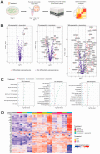DNA-Dependent Protein Kinase Inhibitor Peposertib Potentiates the Cytotoxicity of Topoisomerase II Inhibitors in Synovial Sarcoma Models
- PMID: 38201616
- PMCID: PMC10778103
- DOI: 10.3390/cancers16010189
DNA-Dependent Protein Kinase Inhibitor Peposertib Potentiates the Cytotoxicity of Topoisomerase II Inhibitors in Synovial Sarcoma Models
Abstract
Synovial sarcoma is a rare and highly aggressive subtype of soft tissue sarcoma. The clinical challenge posed by advanced or metastatic synovial sarcoma, marked by limited treatment options and suboptimal outcomes, necessitates innovative approaches. The topoisomerase II (Topo II) inhibitor doxorubicin has remained the cornerstone systemic treatment for decades, and there is pressing need for improved therapeutic strategies for these patients. This study highlights the potential to enhance the cytotoxic effects of doxorubicin within well-characterized synovial sarcoma cell lines using the potent and selective DNA-PK inhibitor, peposertib. In vitro investigations unveil a p53-mediated synergistic anti-tumor effect when combining doxorubicin with peposertib. The in vitro findings were substantiated by pronounced anti-tumor effects in mice bearing subcutaneously implanted tumors. A well-tolerated regimen for the combined application was established using both pegylated liposomal doxorubicin (PLD) and unmodified doxorubicin. Notably, the combination of PLD and peposertib displayed enhanced anti-tumor efficacy compared to unmodified doxorubicin at equivalent doses, suggesting an improved therapeutic window-a critical consideration for clinical translation. Efficacy studies in two patient-derived xenograft models of synovial sarcoma, accurately reflecting human metastatic disease, further validate the potential of this combined therapy. These findings align with previous evidence showcasing the synergy between DNA-PK inhibition and Topo II inhibitors in diverse tumor models, including breast and ovarian cancers. Our study extends the potential utility of combined therapy to synovial sarcoma.
Keywords: DNA repair; DNA-PK; NHEJ; peposertib; synovial sarcoma.
Conflict of interest statement
Steffie Revia, Felix Neumann, Olga Bogatyrova, Astrid Zimmermann, Christiane Amendt, Joachim Albers are employees of Merck Healthcare KGaA, Darmstadt, Germany. Magdalena A. Budzinska is an employee of Ardigen S.A., Podole 76, 30-394, Cracow, Poland.
Figures






Similar articles
-
Peposertib, a DNA-PK Inhibitor, Enhances the Anti-Tumor Efficacy of Topoisomerase II Inhibitors in Triple-Negative Breast Cancer Models.Int J Mol Sci. 2024 May 8;25(10):5120. doi: 10.3390/ijms25105120. Int J Mol Sci. 2024. PMID: 38791158 Free PMC article.
-
Activity of M3814, an Oral DNA-PK Inhibitor, In Combination with Topoisomerase II Inhibitors in Ovarian Cancer Models.Sci Rep. 2019 Dec 11;9(1):18882. doi: 10.1038/s41598-019-54796-6. Sci Rep. 2019. PMID: 31827119 Free PMC article.
-
The DNA-PK Inhibitor AZD7648 Sensitizes Patient-Derived Ovarian Cancer Xenografts to Pegylated Liposomal Doxorubicin and Olaparib Preventing Abdominal Metastases.Mol Cancer Ther. 2022 Apr 1;21(4):555-567. doi: 10.1158/1535-7163.MCT-21-0420. Mol Cancer Ther. 2022. PMID: 35149547
-
Trabectedin: Ecteinascidin 743, Ecteinascidin-743, ET 743, ET-743, NSC 684766.Drugs R D. 2006;7(5):317-28. doi: 10.2165/00126839-200607050-00005. Drugs R D. 2006. PMID: 16922593 Review.
-
Systemic Treatment for Adults with Synovial Sarcoma.Curr Treat Options Oncol. 2018 Mar 7;19(2):13. doi: 10.1007/s11864-018-0525-1. Curr Treat Options Oncol. 2018. PMID: 29516254 Free PMC article. Review.
Cited by
-
Peposertib, a DNA-PK Inhibitor, Enhances the Anti-Tumor Efficacy of Topoisomerase II Inhibitors in Triple-Negative Breast Cancer Models.Int J Mol Sci. 2024 May 8;25(10):5120. doi: 10.3390/ijms25105120. Int J Mol Sci. 2024. PMID: 38791158 Free PMC article.
-
Enhancing Standard of Care Chemotherapy Efficacy Using DNA-Dependent Protein Kinase (DNA-PK) Inhibition in Preclinical Models of Ewing Sarcoma.Mol Cancer Ther. 2024 Aug 1;23(8):1109-1123. doi: 10.1158/1535-7163.MCT-23-0641. Mol Cancer Ther. 2024. PMID: 38657228 Free PMC article.
References
Grants and funding
LinkOut - more resources
Full Text Sources
Research Materials
Miscellaneous

